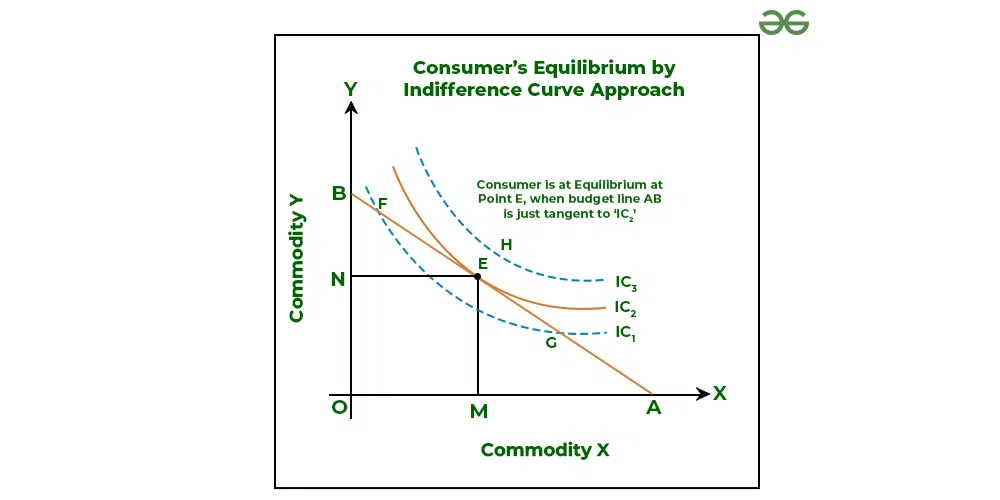What is Consumer’s Equilibrium?
The term equilibrium is used frequently in economic analysis. It is a state of rest or a position of no change, which under a situation provides the maximum gain. A consumer is said to be in equilibrium when he has derived maximum satisfaction and does not want to change his consumption level. Hence, Consumer’s Equilibrium is a situation in which a consumer has maximum satisfaction with limited income and does not tend to change his existing way of expenditure.
The point of equilibrium or maximum satisfaction is achieved by the study of the indifference map and budget line together. An indifference map represents every possible indifference curve that the consumer has, which helps in ranking their preferences. The combination of goods on the higher indifference curve gives a higher satisfaction level to the consumer. Therefore, the highest of the indifference curves of an indifference map is preferred by a consumer.
Conditions of Consumer’s Equilibrium
Consumer’s equilibrium can be achieved with the help of indifference curve theory only after meeting the following two conditions:
1. MRSXY = Ratio of Prices or = Market Rate of Exchange (MRE)
Suppose there are two goods, X and Y. The first condition would be
- If MRS_{XY}>\frac{P_X}{P_Y}, it means that as compared to the market requirements, to obtain one more unit of Good X, the consumer is willing to sacrifice more units of Good Y. This situation induces the consumer to purchase more of Good X, resulting in a fall in MRS till it becomes equal to the \frac{P_X}{P_Y} and equilibrium is achieved.
Simply put, MRS_{XY}>\frac{P_X}{P_Y}~or~MRE means that the rate at which the consumer is willing to sacrifice more of Y to obtain one additional unit of X; i.e., MRS is more than the rate at which the consumer has to sacrifice Y to obtain one additional unit of X; i.e., MRE. - If
, it means that as compared to the market requirements, to obtain one more unit of Good X, the consumer is willing to sacrifice less units of Good Y. This situation induces the consumer to purchase less of Good X and more of Good Y, resulting in a rise in MRS till it becomes equal to the \frac{P_X}{P_Y} and equilibrium is achieved.
2. MRS continuously falls
Another condition for consumer’s equilibrium is that the Marginal Rate of Substitution (MRS) at the equilibrium point must be diminishing. In simple terms, at the point of equilibrium, the indifference curve must be convex to the origin. Also, one cannot achieve the equilibrium point, unless the Marginal Rate of Substitution (MRS) falls.
After fulfilling both the above-mentioned conditions, a consumer is said to be in equilibrium.

In the above graph, IC1, IC2, and IC3 are three indifference curves, and AB is the budget line. The highest indifference curve that a consumer can reach with the budget line’s constraint is IC2. The budget line AB is tangent to the indifference curve IC2 at point E. This point is the point of equilibrium, where the consumer buys OM quantity of Good X and ON quantity of Good Y.
The other points, i.e., F and G to the left or right of point E lie on the lower indifference curve IC1, indicating a lower level of satisfaction. Also, as the budget line can be tangent to only one indifference curve, the consumer maximises his level of satisfaction at point E when he meets both conditions of the consumer’s equilibrium, which are:
1. MRSXY = Ratio of Prices or = Market Rate of Exchange (MRE)
OR
Slope of Indifference Curve = Slope of Budget Line
At the point of tangent, i.e., point E, the absolute value of the slope of the indifference curve; i.e., MRS between Good X and Good Y, and that of the budget line; i.e., price ratio are the same. Also, the consumer cannot attain equilibrium at the points left to E and right to E because at all those points MRS_{XY}>\frac{P_X}{P_Y} and MRS_{XY}<\frac{P_X}{P_Y} respectively. Hence, equilibrium is attained only at the point where MRS_{XY}=\frac{P_X}{P_Y}; i.e., point E.
2. MRS continuously falls: The second condition of consumer’s equilibrium is also achieved at point E. It is because at this point MRS is diminishing, which means that IC2 is convex to the origin here.
Leave a Reply